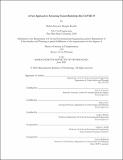A Fare Approach to Attracting Transit Ridership After COVID-19
Author(s)
Morgan-Roselló, Rubén Grayson
DownloadThesis PDF (3.101Mb)
Advisor
Attanucci, John P.
Zhao, Jinhua
Whittle, Andrew
Terms of use
Metadata
Show full item recordAbstract
The COVID-19 global pandemic substantially depressed ridership on transit agencies across North America. While much is still unknown about the anticipated return of transit ridership after the pandemic, the exacerbation of previous work-from-home trends due to continued remote work policies can negatively affect transit ridership recovery and the use of traditional pass fare products. For example, an increase in work-from-home flexibility after employees return to the office is likely to affect the ongoing establishment of “pass multiples”, or the “break-even” point, for monthly passes. This thesis examines two case studies of potential new or modified fare products and one randomized control trial and suggests a strategy for transit agencies to attract ridership as employers reopen their downtown offices. The research analyzes the Massachusetts Bay Transportation Authority (MBTA), the regional transit agency for Greater Boston and one of the largest in the nation. A focus on commuter rail users and the Perq program (the corporate pass program at the MBTA) narrows the analysis to traditional peak commuters (AM and PM frequent peak riders). The first case study dissects a new pass option that was introduced early in the COVID-19 pandemic known as the Flex Pass. While an honorable attempt at providing a flexible pass option during a time of uncertainty, alternative pass structures and heavier discounts will likely be necessary to attract more users to this, or an alternative, fare product. Based on an analysis using pre- and during COVID-19 commuter rail individual passenger usage, an alternative more heavily discounted 20/30 (20 trips within 30 days) fare product is recommended to replace the Flex Pass along with increased discounts on the Monthly Pass. Additionally, a randomized control trial conducted just before the pandemic shows how an email marketing campaign can be used to increase pass product adoption among regular system users. Coupled with the new 20/30 fare product and an increased discount on the Monthly Pass from the first case study, the email marketing campaign can help quickly roll out a new product to meet ever-shifting travel behaviors. Finally, a new employer-based fare product, named the Mobility Pass (a pay-per-use product for employers that functions as an unlimited pass for employees and requires all benefits-eligible employees be covered and is heavily subsidized by the employer), is analyzed to show the ridership growth potential if rolled out to all employers in the Perq program (as well as those who use third party employee benefit administrators). These three tactics can be used to increase ridership as transit agencies seek to recover from a global pandemic and historically low ridership.
Date issued
2021-06Department
Massachusetts Institute of Technology. Department of Civil and Environmental Engineering; Massachusetts Institute of Technology. Department of Urban Studies and PlanningPublisher
Massachusetts Institute of Technology